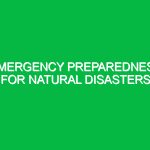Introduction
Safety Training for Emergency Responders is vital in the Health, Safety, and Environment (HSE) domain. This training equips responders with the necessary skills and knowledge to effectively handle emergencies, ensuring not only their safety but also the safety of those they serve. In the face of natural disasters, hazardous materials incidents, and other emergencies, the ability to respond quickly and effectively can mean the difference between life and death.
Imagine a scenario where a chemical spill occurs in an industrial area. Emergency responders rush to the scene, but without adequate training, they may not know how to assess the situation properly or protect themselves from harmful chemicals. This is where comprehensive safety training becomes crucial. It prepares responders to tackle the unpredictable nature of emergencies, fostering a culture of safety that can save lives.
Understanding All Hazards and Risks
Emergency responders face a myriad of hazards and risks in the field. These can range from environmental dangers to physical threats. Understanding these hazards is the first step in effective safety training.
Potential Hazards
1. Biological Hazards: Responders may encounter infectious diseases or hazardous biological materials. For example, during a pandemic, handling potentially infected individuals without proper precautions can lead to contamination.
2. Chemical Hazards: Exposure to toxic substances is a serious risk. Responders dealing with chemical spills must be trained to recognize hazardous materials and understand their effects on health.
3. Physical Hazards: The risk of slips, trips, and falls is ever-present in emergency situations. Additionally, responders may face dangers from fire, explosions, or unstable structures.
4. Psychological Hazards: The stress of responding to emergencies can lead to mental health issues. Training should address the psychological impacts of trauma and provide coping strategies.
5. Environmental Hazards: Natural disasters such as floods, earthquakes, and hurricanes present unique challenges. Responders must be trained to navigate these conditions safely.
Safety Precautions and Best Practices
To mitigate these hazards, specific safety precautions and best practices must be integrated into safety training for emergency responders. Here’s a closer look at actionable advice that can enhance safety.
Personal Protective Equipment (PPE)
One of the most crucial aspects of safety training is the proper use of personal protective equipment (PPE). Responders must be familiar with different types of PPE suitable for various scenarios. For example, in a chemical spill, responders should wear chemical-resistant suits, gloves, eye protection, and respiratory devices. Training should include:
- How to select appropriate PPE for specific hazards.
- Proper donning and doffing techniques to prevent contamination.
- Regular inspections and maintenance of PPE to ensure its effectiveness.
Situational Awareness
Developing situational awareness is critical for emergency responders. This involves recognizing potential threats and understanding the environment. Training should focus on:
- Identifying signs of danger in the surroundings, such as smoke, unusual odors, or structural instability.
- Understanding the behavior of crowds and individuals during emergencies.
- Utilizing technology, such as drones or mobile apps, to assess situations from a safe distance.
Effective Communication
Clear communication is essential during emergencies. Training should encompass:
- Establishing communication protocols among responders and with command centers.
- Using radios and other communication devices effectively, especially in noisy or chaotic environments.
- Practicing debriefing sessions post-incident to improve future responses.
First Aid and Medical Response
Emergency responders must be trained in basic first aid and medical response. This includes:
- Recognizing and treating common injuries such as burns, cuts, and fractures.
- Administering CPR and using automated external defibrillators (AEDs).
- Understanding the importance of triage in mass casualty situations.
Stress Management and Mental Health
Training must address the psychological toll of emergency response work. Responders should learn strategies for managing stress, such as:
- Mindfulness techniques to stay calm under pressure.
- Peer support systems to discuss experiences and feelings.
- Access to mental health resources for ongoing support.
Regulations and Standards
Safety training for emergency responders is governed by several regulations and standards that ensure a baseline of knowledge and competency. Key regulations include:
Occupational Safety and Health Administration (OSHA)
OSHA has established guidelines that cover various aspects of safety training. For instance, the Hazardous Waste Operations and Emergency Response (HAZWOPER) standard requires training for those who respond to hazardous substance emergencies. It highlights the importance of understanding chemical hazards and the proper use of PPE.
National Fire Protection Association (NFPA)
The NFPA sets standards for fire service training, including the necessity for emergency responders to complete training in fire suppression, rescue operations, and hazardous materials response. Their standards ensure responders are well-prepared for fire-related emergencies.
Federal Emergency Management Agency (FEMA)
FEMA provides comprehensive training programs for emergency management professionals. Their courses cover a wide range of topics, including incident command systems, emergency operations planning, and crisis management. These resources are invaluable for enhancing the skills of emergency responders.
Conclusion
In conclusion, Safety Training for Emergency Responders is indispensable in the HSE domain. By understanding the potential hazards, implementing best practices, and adhering to established regulations, emergency responders can significantly enhance their preparedness and effectiveness. This training not only protects the responders themselves but also ensures the safety of the communities they serve.
Ultimately, investing in safety training is an investment in life. Whether it’s through hands-on drills, simulations, or classroom instruction, the goal remains clear: to equip responders with the knowledge and skills necessary to face any emergency with confidence and competence. As the saying goes, “An ounce of prevention is worth a pound of cure.” In the realm of emergency response, this could not be more accurate.


